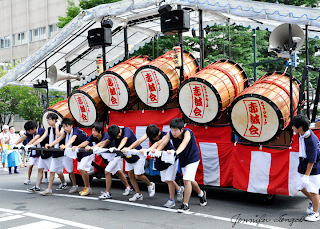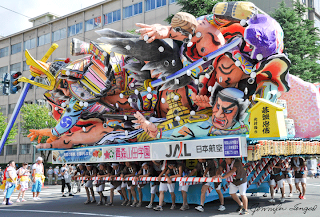Saturday, August 7: Afternoon Nebuta Parade
The Tohoku region hosts other Nebuta Festivals in various places; yet, the one in Aomori is the most famous. Every year, over three million visitors flock to Aomori City in the span of six days to watch 20 illuminated floats light the night sky. Another attraction of the Nebuta Matsuri is the very wild dances performed by 100s of male and female participants, called haneto, who march and dance merrily to the sounds of taiko drums and festival music, chanting "Rasse-rah, rasse-rah." Anyone can join the fun as a haneto by renting a costume from a local shop.
The Nebuta Festival takes place from August 2 to 7 in Aomori City. They begin parading along a 2.5-kilometer (1.5 mile) course. Lanterns are illuminated as dusk approaches (around 18:30) evening and finish up around 21:00. The peak comes on August 5 and 6, when the largest number of floats are out. On the final day, August 7, floats begin their procession about one o’clock in the afternoon. After the parade, floats can be viewed at ASPM. Later that the evening, three floats judged to be the best are taken to the sea and placed on ships for a cruise around the port of Aomori and fireworks wrap up the festival.


Be prepared for some VERY crowded conditions. Perhaps the best way to get there and back is by train (¥1280 each way). Although driving is discouraged because of the lack of public parking, we decided to pack the car and two children to head to Aomori City. After all, Kyle and I drove to Pasedena one New Year’s Day to watch a Rose Bowl Tournament Game, so I figured we could brace this crowd. After almost two hours via the scenic route, we arrived at our destination. The roads were closed at the police station on National Road 4, about four blocks from where the route took place, so we were detoured.
Unfortunately, we had a late start – it seems our timing is off with small children – and caught the last half of the parade. When the kids are older, I think I’d like to make this trip again to see the evening parade. The gallantry of the floats is somewhat less regal during the day. Not to mention, taking photos posed somewhat of a challenging because I am short (5'00"), tried to maneuver between people, keep an eye on my sleeping son and belongings, as well as switch between camera and camcorder; Kyle was feeding Talia. Life before children was so much easier, but we've become accustomed to the hustle and bustle. After all, it's only on the weekends, weekdays we stay home.








Aomori Tourist and Convention Center
Tel. 017-723-7211
www.nebuta.jp/english/index_e.htm











